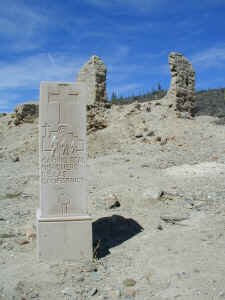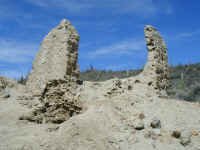|
Missions of Baja California
|

|
In January of 1633 the Spanish government provisioned three ships with 200 men. Commanded by the governor of Sinaloa, Isidro de Atondo y Antillon and accompanied by Jesuit priest Eusebio Kino the ships landed in La Paz. The first settlement at La Paz was soon abandoned because of hostile locals. They tried again near Loreto but this attempt also failed. Kino and Atondo y Antillon returned to the mainland where Kino went on to establish several missions in the northwest. It wasn’t until 1695 that another Jesuit priest named Juan Maria Salvatierra finally managed to establish a permanent Spanish settlement in Loreto. Mission Nuestra Senora de Loreto, soon became the peninsula’s religious and administrative capital. From here, other Jesuits went out to establish missions throughout the area, founding a total of 23 over the next 70 years.
Along with religion, the Jesuits brought diseases that the native people had never been exposed to. By 1767, epidemics of smallpox, plague, typhus, measles and venereal diseases had decimated the population. Out of an initial population of about 48,000 only 8,000 still remained.
But while a decline in population threatened the existence of the missions, it was the Spanish government who ended the Jesuit efforts. Rumor had it that the Jesuit priests had amassed a fortune on the peninsula and they were becoming very powerful. After word made it back to Spain, King Carlos III had them expelled from Baja at gunpoint and ordered them back to Spain.
The Franciscans & The Dominicans
Next came the Franciscans, under the authority of Father Junipero Serra. They closed or consolidated several of the existing missions and established one of their own, San Fernando Velicata. However Father Serra was to have greater duties thrust upon him. Along with Gaspar de Portola, he was ordered by the Spanish government to push north and establish missions in Alta (upper) California. This venture, which gave birth of 21 missions in Baja California and Alta California (which later became California), was 200 years later to result in the beatification of Junipero Serra by the Catholic Church.
In 1772 the Dominicans arrived and by 1800 had established nine more missions in the northern part of Baja. They also continued to run the Jesuit missions. But by 1810 Mexico had risen up to end the Spanish rule and the days of the mission system of government were numbered. Mexico gained its independence in 1821 and in 1832, after Baja became a federal territory, the governor put an end to the mission system by converting the missions into parish churches
Misión San Ignacio Kadakaamán
Misión San Vicente Ferrer
|
|
|
 Misión San Fernando Rey de España de Velicatá |
Jesuit Establishments (1683-1767)
- Misión San Bruno (1683-1685)
- Misión Nuestra Senora de Loreto Conchó (1697-1829)
- Visita de San Juan Bautista Londó (1699-1745)
- Misión San Francisco Javier Vigge Biaundó (1699-1817)
- Misión San Juan Bautista Malbat (Liguí) (1705-1721)
- Misión Santa Rosalia de Mulegé (1705-1828)
- Misión San Jose de Comondú (1708-1827)
- Misión La Purisima Concepción de Cadegomó (1720-1822)
- Misión de Nuestra Señora del Pilar de La Paz Airapí (1720-1749)
- Misión Nuestra Senora de Guadalupe de Huasinapi (1720-1795)
- Misión Santiago de Los Coras (1721-1795)
- Misión Nuestra Senora de los Dolores del Sur Chillá (1721-1768)
- Misión San Ignacio Kadakaamán (1728-1840)
- Misión Estero de las Palmas de San José del Cabo Añuití (1730-1840)
- Misión Santa Rosa de las Palmas (Todos Santos) (1733-1840)
- Misión San Luis Gonzaga Chiriyaqui (1740-1768)
- Misión Santa Gertrudis (1752-1822)
- Misión San Francisco Borja (1762-1818)
- Visita de Calamajué (1766-1767)
- Misión Santa María de los Angeles (1767-1768)
- Franciscan Establishments (1768-1773)
- Misión San Fernando Rey de España de Velicatá (1772-1818)
- Visita de la Presentación (1769-1817)
Dominican Establishments (1774-1849)
- Misión Nuestra Señora del Santísimo Rosario de Viñacado (1774-1832)
- Visita de San José de Magdalena (1774-1828)
- Misión Santo Domingo de la Frontera (1775-1839)
- Misión San Vicente Ferrer (1780-1833)
- Misión San Miguel Arcangel de la Frontera (1797-1834)
- Misión Santo Tomás de Aquino (1791-1849)
- Misión San Pedro Mártir de Verona (1794-1824)
- Misión Santa Catalina Vírgen y Mártir (1797-1840)
- Visita de San Telmo (1798-1839)
- Misión El Descanso (San Miguel la Nueva) (1817-1834)
- Misión Nuestra Senora de Guadelupe del Norte (1834-1840)
Franciscan Establishments
- Misión San Fernando Rey de España de Velicatá (Established by Father Junipero Sierra in 1769 and taken over by the Dominicans in 1772) This is the only Franciscan mission built in Baja.
|
Home Welcome to Baja Missions of Baja |